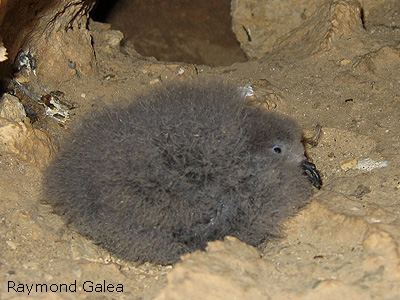(Incubating Mediterranean storm petrel. Image courtesy of Birdwatching in Malta.)
This group (which also includes albatrosses, shearwaters, and a number of other petrels) is threatened by habitat destruction, pollution, fishing, and predation. Conservation efforts often target the birds' breeding grounds, where managers are particularly interested in improving nesting habitat and removing threats to egg safety. One measure that seemed likely to achieve both of these goals simultaneously was the introduction of nest boxes, which might not only provide extra space for more pairs to lay eggs, but also protect the eggs against environmental hazards.
According to a short communication in the most recent issue of Biological Conservation, the boxes do, indeed, appear to improve petrel demographic parameters. These encouraging results were obtained by a team of Mediterranean researchers who monitored storm petrel nesting efforts on Spain's Benidorm Island from 1993-2010. They captured and banded breeding individuals, monitored nesting success, and kept records on petrel movement between natural and artificial cavities. All of these demographic data were entered into models allowing the researchers to estimate survival, recapture, breeding success, and change-of-nest-type probabilities.
(Spain's Benidorm Island. Image courtesy of Wikipedia.)
When researchers first started monitoring the petrels, there were 64 breeding pairs in their focal cave. By the year that the nest boxes were first installed, this number had decreased to only 36 pairs. After introduction of the boxes, however, the number of pairs increased fairly steadily, peaking at 108 boxes in 2006 and then plateauing thereafter. After their initial capture and banding, nest box breeders were 22% more likely to be recaptured than breeders using natural sites; more importantly, survival was 7% higher among birds using nest boxes. Pairs that laid eggs in nest boxes had 19% higher breeding success, which is probably why population growth rates based on nest box data were notably higher than those based on data from natural nests.
One parameter that did not vary much between the two groups was the likelihood of moving from one type of nest site to the other; transition probability was only 0.6% from natural nests to nest boxes, and 0.4% for the reverse. The researchers suspect that older, established breeders preferred to nest in "traditional" locations, and that nest boxes were used by new breeders who found the artificial cavities while prospecting for their first nest sites. Typically, younger breeders would be less successful than older ones, so the fact that box-nesters did so well suggests that the boxes themselves were responsible for the higher survival and productivity rates observed here.
(Mediterranean storm petrel chick. Image courtesy of Birdwatching in Malta.)
In fact, survival rates of nest box breeders were similar to those found in colonies where predation rates are lower. This suggests that the boxes were offering protection from predators such as yellow-legged gulls (Larus michahellis)--some of whom specialize in petrel hunting. The authors report that this outcome was actually a happy coincidence, since the main purpose of nest box installation was to increase the number of nest sites available and, hopefully, improve breeding success by shielding eggs from trampling and falling rocks.
Unfortunately, the petrels only "took" to the boxes in the section of Benidorm Island where natural nest sites were lacking. In other words, it may be difficult to convince all petrels to occupy these cavities, no matter how safe they may be. The researchers offer one other caution: The increased breeding densities caused by nest box use could lead to problems associated with resource limitation or disease; further work will be needed to investigate this. On the whole, though, the results of the study are very encouraging, not only for Mediterranean storm petrels, but also for other sea birds that might benefit from similar conservation measures.
---
Libois, E., Gimenez, O., Oro, D., Minguez, E., Pradel, R., Sanz-Aguilar, A. 2012. Nest boxes: a successful management tool for the conservation of an endangered seabird. Biological Conservation 155:39-43.



No comments:
Post a Comment